Are you a Quiet Speculation member?
If not, now is a perfect time to join up! Our powerful tools, breaking-news analysis, and exclusive Discord channel will make sure you stay up to date and ahead of the curve.
Modern prices have been rising since the format's birth, but 2015 brought these spikes to new levels. The last six months since the January ban announcement have seen price jumps across the format, both on staple effects and on wild speculation targets. Liliana of the Veil climbed from about $55 to a TCGPlayer average of $98 since January. Snapcaster Mage jumped from $33 to $75 in the same time frame. We saw Blood Moon double from $25 to $50 in about two months and cards like Gilt-Leaf Palace spike almost 1000% overnight. This isn't what many players expected of a format billed as not having "the card availability problems of Legacy", and it has led many player to question Modern's effectiveness.
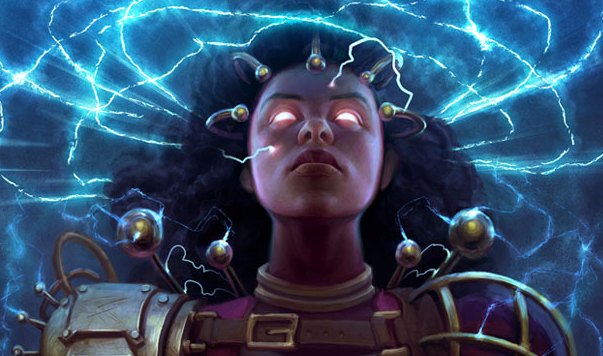
As a longtime Modern supporter, I see why many people are worried about the relationship between price spikes and longterm format health. Legacy will always be hamstrung by the much-maligned Reserve List, which leaves Modern as the non-rotating format where card availability shouldn't be an issue. Then again, if Modern prices spike so much that they are comparable to Legacy ones, who cares how "available" the cards really are? Why not play Legacy if the formats have similar prices? To answer these kinds of questions, I'll compare the prices of key Legacy decks to Modern ones. This will help us check if you can play competitively in both formats on similar budget, or if one is actually cheaper or pricier than the other.
[wp_ad_camp_1]
Rising Modern Prices
Back in early July, MTG Goldfish published an article showing a 25% price increase in Modern over just the last six months. Price differences ranged from 12%-15% for decks like RG Tron and Affinity, 25%-30% 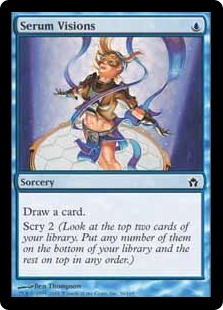 for Grixis Twin and Burn, and around 60% for Elves and Amulet Bloom. Although some decks held value (Jund only jumped by a negligible 2%), the overall picture was one of increasing Modern prices. This was perhaps most notable in individual card prices, if not necessarily the decks using them. Cards like Snapcaster, Moon, and Liliana rose over 90% (over 100% in Snapcaster's case). Modern Masters may have driven down prices for staples like Confidant (down about 50%) and Tarmogoyf (-25%), but any card excluded from the set skyrocketed in the opposite direction. Modern hallmarks like Inkmoth Nexus, Cavern of Souls, and Aether Vial all saw huge price increases since the Modern community confirmed their MM2015 absence. Even uncommons and commons weren't immune to this effect: see Heritage Druid ($18.50), Might of Old Krosa ($8.99), and the embarrassing Serum Visions ($13.10).
for Grixis Twin and Burn, and around 60% for Elves and Amulet Bloom. Although some decks held value (Jund only jumped by a negligible 2%), the overall picture was one of increasing Modern prices. This was perhaps most notable in individual card prices, if not necessarily the decks using them. Cards like Snapcaster, Moon, and Liliana rose over 90% (over 100% in Snapcaster's case). Modern Masters may have driven down prices for staples like Confidant (down about 50%) and Tarmogoyf (-25%), but any card excluded from the set skyrocketed in the opposite direction. Modern hallmarks like Inkmoth Nexus, Cavern of Souls, and Aether Vial all saw huge price increases since the Modern community confirmed their MM2015 absence. Even uncommons and commons weren't immune to this effect: see Heritage Druid ($18.50), Might of Old Krosa ($8.99), and the embarrassing Serum Visions ($13.10).
Some players do not find these trends worrisome, or even unexpected. As Modern becomes more popular, prices are virtually guaranteed to rise. It will happen even if Wizards tries to meet 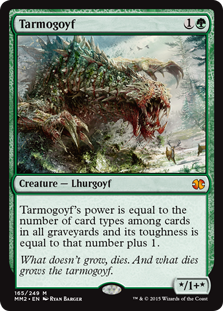 demand with supply increases through reprints and Modern Masters-style sets. This also relates to a classic eternal/nonrotating format argument about the difference between card "price" and card "availability". Did Wizards promise a format to solve card availability issues? Yes! Did they promise one to solve card price issues? Not explicitly, and maybe not even implicitly depending on how you define "availability" (Wizards hasn't). I don't want to get too involved in this argument here and you shouldn't either. Whether or not Wizards acknowledges Modern prices as a problem, the community is certainly worried. We all know players who don't care how "available" a Tarmogoyf is if it's still about $150. This article assumes that rising prices are a potential source of worry, especially for those who fear for Modern's longterm health.
demand with supply increases through reprints and Modern Masters-style sets. This also relates to a classic eternal/nonrotating format argument about the difference between card "price" and card "availability". Did Wizards promise a format to solve card availability issues? Yes! Did they promise one to solve card price issues? Not explicitly, and maybe not even implicitly depending on how you define "availability" (Wizards hasn't). I don't want to get too involved in this argument here and you shouldn't either. Whether or not Wizards acknowledges Modern prices as a problem, the community is certainly worried. We all know players who don't care how "available" a Tarmogoyf is if it's still about $150. This article assumes that rising prices are a potential source of worry, especially for those who fear for Modern's longterm health.
Legacy vs. Modern Prices: Tier 1 Decks
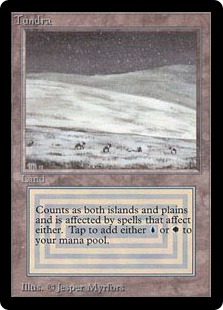 Because Wizards isn't going back on the Reserve List, no matter how many reddit, Source, and Salvation players argue otherwise, Legacy will continue to have reprint issues. That's bad news for Legacy prices. Unless the format gets less popular or someone discovers a bunch of Revised boxes in their basement, it means cards like Tropical Island and Tundra are unlikely to fall too far below $180 in the near future. But as we saw in the section above, Modern prices are also rising fast, with some cards already reaching Legacy levels. This leads us to ask: should we all just be playing Legacy instead? Or, stated another way, is Modern secretly just as expensive as Legacy (especially with all of the recent spikes)?
Because Wizards isn't going back on the Reserve List, no matter how many reddit, Source, and Salvation players argue otherwise, Legacy will continue to have reprint issues. That's bad news for Legacy prices. Unless the format gets less popular or someone discovers a bunch of Revised boxes in their basement, it means cards like Tropical Island and Tundra are unlikely to fall too far below $180 in the near future. But as we saw in the section above, Modern prices are also rising fast, with some cards already reaching Legacy levels. This leads us to ask: should we all just be playing Legacy instead? Or, stated another way, is Modern secretly just as expensive as Legacy (especially with all of the recent spikes)?
To help answer this, I compared deck prices between the two formats. For Modern, this meant the current list of tier 1 decks from our Top Decks page, which was just updated last week (I added Abzan to this article because its position and Jund's are somewhat interchangeable). Looking to Legacy, I used The Source's "Decks to Beat" list, focusing on their most recent July 2015 update. I wanted to compare tier 1 decks because these are the most reliable finishers in both formats. Every format has cheaper outliers in tier 2 and lower, but as an entry-level player into the nonrotating scene, you are probably going to start with a more established, tier 1 option. We already know Modern prices are up since January, and this analysis will help us see how those prices compare to Legacy.
To select representative lists, I took the highest-finishing deck from the largest event within the last 1-2 months. This was done both to reflect the "best" deck, and also the deck a player was mostly likely to build after netdecking a list. All prices reflect the TCGPlayer middle prices and include sideboards (we'll exclude them later too).
Legacy Tier 1 Deck Prices: Baseline
| Deck | Overall Price | Average Card Price |
|---|---|---|
| OmniTell | $2051.17 | $28.36 |
| Miracles | $2977.42 | $37.09 |
| Grixis Control | $3059.46 | $31.34 |
| Jeskai Stoneblade | $2853.60 | $35.60 |
| Temur Delver | $3278.62 | $42.42 |
| Death and Taxes | $1816.06 | $21.37 |
| Sultai Delver | $3438.04 | $41.16 |
| UG Infect | $2360.52 | $31.53 |
- Average Legacy deck price: $2729.36
- Average Legacy card price: $33.61
- Legacy deck price low: Death and Taxes ($1816.06)
- Legacy deck price high: Sultai Delver ($3438.04)
Modern Tier 1 Deck Prices: Baseline
| Deck | Overall Price | Average Card Price |
|---|---|---|
| Jund | $1922.47 | $18.75 |
| Affinity | $759.41 | $9.68 |
| Burn | $594.24 | $7.13 |
| Grixis Control | $1188.10 | $13.48 |
| Grixis Twin | $1229.10 | $13.94 |
| UR Twin | $1311.72 | $15.72 |
| RG Tron | $800.51 | $11.99 |
| Abzan | $1918.67 | $19.05 |
- Average Modern deck price: $1215.53
- Average Modern card price: $13.72
- Modern deck price low: Burn ($594.24)
- Modern deck price high: Jund ($1922.47)
It doesn't take a lot of analysis to see the huge difference between Modern and Legacy prices. The average tier 1 Legacy deck is more than twice as expensive as the average Modern one. This is also true 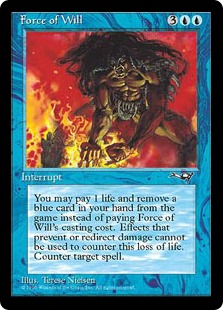 of the average card price in those two formats. Modern has some expensive outliers with Legacy-level prices, namely Jund and Abzan, but those decks are still cheaper than seven of the other eight decks in Legacy's tier 1. On the Modern side of things, Liliana of the Veil and Tarmogoyf are two of the biggest contributors to high deck prices. It's no coincidence that the two most expensive Modern decks are also the only two tier 1 Modern decks to play Goyf. Legacy is more mixed, with expensive cards sneaking into decks no matter what strategy they are playing: Show and Tell, Force of Will, and Wasteland all add up over the different lists. On its own, this table handily discredits the argument about Modern being as expensive as Legacy, but we also want to dive deeper to address some other takes on the debate.
of the average card price in those two formats. Modern has some expensive outliers with Legacy-level prices, namely Jund and Abzan, but those decks are still cheaper than seven of the other eight decks in Legacy's tier 1. On the Modern side of things, Liliana of the Veil and Tarmogoyf are two of the biggest contributors to high deck prices. It's no coincidence that the two most expensive Modern decks are also the only two tier 1 Modern decks to play Goyf. Legacy is more mixed, with expensive cards sneaking into decks no matter what strategy they are playing: Show and Tell, Force of Will, and Wasteland all add up over the different lists. On its own, this table handily discredits the argument about Modern being as expensive as Legacy, but we also want to dive deeper to address some other takes on the debate.
A common objection to this analysis concerns the inclusion of dual lands. Cards like Tundra, Underground Sea, Volcanic Island, and the other original duals are some of the most expensive cards in Legacy, and they can artificially trend decks towards higher valuations. To account for this, I recalculated all of the Legacy deck prices excluding their dual lands. This scenario assumes you have a supply of shocklands on hand, or maybe just borrow duals from a Legacy buddy. I'll add in the old price columns as a point of comparison, along with the percentage change.
Legacy Tier 1 Deck Prices: No Duals
| Deck | No Duals Overall Price | With Duals Overall Price | Duals to No Duals Change | No Duals Avg Card Price | With Duals Avg Card Price |
|---|---|---|---|---|---|
| OmniTell | $1522.07 | $2051.17 | -26% | $20.22 | $28.36 |
| Miracles | $1589.92 | $2977.42 | -47% | $23.23 | $37.09 |
| Grixis Control | $1176.26 | $3059.46 | -62% | $15.44 | $31.34 |
| Jeskai Stoneblade | $1532.70 | $2853.60 | -46% | $22.97 | $35.60 |
| Temur Delver | $1834.74 | $3278.62 | -44% | $21.91 | $42.42 |
| Death and Taxes | $1816.06 | $1816.06 | -0% | $21.37 | $21.37 |
| Sultai Delver | $2065.87 | $3438.04 | -40% | $28.23 | $41.16 |
| UG Infect | $1630.96 | $2360.52 | -31% | $26.96 | $31.53 |
- Average Legacy deck price (no duals): $1646.07
- % change from with-dual prices: -40%
- Average Legacy card price (no duals): $22.54
- % change from with-dual prices: -33%
Removing duals knocks a huge chunk out of the Legacy deck prices. Death and Taxes obviously wasn't going to benefit much from this, but every other deck enjoys at least a 26% price 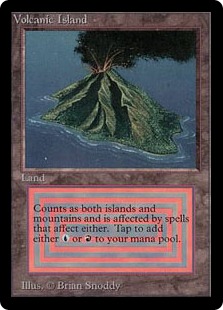 reduction. Grixis Control is the big winner here with a 62% price drop: that's the price you have to pay for those 4 Volcanic Islands and 2 Underground Seas. Comparing between formats, this makes seven of the eight tier 1 Legacy decks cheaper than two Modern options: Jund and Abzan. With the exception of Legacy's Grixis Control, all of the Legacy decks are still more expensive than the non-BGx Modern ones. Even the expensive Twin decks beat out the Legacy Ux strategies, and that's after removing the Reserve List posterchildren. This table shows both the price issues with Legacy that exist beyond the dual lands alone, but also just how much those dual prices affect Legacy decks. 40% of a tier 1 Legacy deck's cost is bundled in the 4-8 duals alone, which is a price issue Modern doesn't share.
reduction. Grixis Control is the big winner here with a 62% price drop: that's the price you have to pay for those 4 Volcanic Islands and 2 Underground Seas. Comparing between formats, this makes seven of the eight tier 1 Legacy decks cheaper than two Modern options: Jund and Abzan. With the exception of Legacy's Grixis Control, all of the Legacy decks are still more expensive than the non-BGx Modern ones. Even the expensive Twin decks beat out the Legacy Ux strategies, and that's after removing the Reserve List posterchildren. This table shows both the price issues with Legacy that exist beyond the dual lands alone, but also just how much those dual prices affect Legacy decks. 40% of a tier 1 Legacy deck's cost is bundled in the 4-8 duals alone, which is a price issue Modern doesn't share.
What about sideboards? For all you budget-minded players out there, trimming expensive sideboard staples is a great way to cut deck costs. As an example, cutting that Fulminator Mage playset out of your Jund, Abzan, or Grixis Control sideboard can save you about $80 on your deck. Or take Legacy's Flusterstorm, which will cost you roughly $65.40 per copy. Here are the Legacy and Modern baslines again, recalculated to exclude sideboard cards.
Legacy Tier 1 Deck Prices: No Sideboard
| Deck | No Board Overall Price | With Board Overall Price | Board to No Board Change | No Board Avg Card Price | With Board Avg Card Price |
|---|---|---|---|---|---|
| OmniTell | $1938.98 | $2051.17 | -5% | $39.12 | $28.36 |
| Miracles | $2581.64 | $2977.42 | -13% | $46.43 | $37.09 |
| Grixis Control | $2852.86 | $3059.46 | -7% | $45.75 | $31.34 |
| Jeskai Stoneblade | $2632.69 | $2853.60 | -8% | $44.12 | $35.60 |
| Temur Delver | $3068.85 | $3278.62 | -6% | $60.78 | $42.42 |
| Death and Taxes | $1736.08 | $1816.06 | -4% | $30.07 | $21.37 |
| Sultai Delver | $3124.33 | $3438.04 | -9% | $52.07 | $41.16 |
| UG Infect | $1913.44 | $2360.52 | -19% | $27.40 | $31.53 |
- Average Legacy deck price (no sideboard): $2481.11
- % change from with-sideboard price: -9%
- Average Legacy card price (no sideboard): $43.22
- % change from with-sideboard price: +28%
Modern Tier 1 Deck Prices: No Sideboard
| Deck | No Board Overall Price | With Board Overall Price | Board to No Board Change | No Board Avg Card Price | With Board Avg Card Price |
|---|---|---|---|---|---|
| Jund | $1791.59 | $1922.47 | -7% | $23.98 | $18.75 |
| Affinity | $605.99 | $759.41 | -20% | $10.04 | $9.68 |
| Burn | $560.83 | $594.24 | -6% | $9.03 | $7.13 |
| Grixis Control | $1001.40 | $1188.10 | -16% | $14.55 | $13.48 |
| Grixis Twin | $1061.85 | $1229.10 | -14% | $15.24 | $13.94 |
| UR Twin | $1171.76 | $1311.72 | -11% | $17.75 | $15.72 |
| RG Tron | $697.72 | $800.51 | -13% | $12.98 | $11.99 |
| Abzan | $1791.90 | $1918.67 | -7% | $24.88 | $19.05 |
- Average Modern deck price (no sideboard): $1058.38
- % change from with-sideboard price: -10%
- Average Modern card price (no sideboard): $16.06
- % change from with-sideboard price: +17%
For the most part, sideboards make up about 10% of a deck's total cost, which makes them a quick way to save money on your tier 1 investment. Unfortunately for both formats, 10% isn't that much in savings,  especially if you are comparing between Modern and Legacy. We can see a big reason for this in the average card prices, which actually increase when you exclude sideboard cards. This is because sideboard cards (with a few exceptions like FoW and Karakas in Infect or Moon in Twin) are relatively inexpensive. Another factor is how people build sideboards, which leans towards singleton bullets and not playsets. When you're only running one Blood Moon instead of three, that's $100 back in your wallet. Even cutting all the Legacy sideboard cards, the deck cost average is still twice that of Modern (assuming we leave in the Modern sideboard cards). Both formats see some standout sideboard-savers like Infect in Legacy (which drops to Modern Jund/Abzan price levels) and Affinity in Modern (enjoying a 20% price drop down to Burn levels), but most sideboards aren't taking up a big enough share of deck price to matter.
especially if you are comparing between Modern and Legacy. We can see a big reason for this in the average card prices, which actually increase when you exclude sideboard cards. This is because sideboard cards (with a few exceptions like FoW and Karakas in Infect or Moon in Twin) are relatively inexpensive. Another factor is how people build sideboards, which leans towards singleton bullets and not playsets. When you're only running one Blood Moon instead of three, that's $100 back in your wallet. Even cutting all the Legacy sideboard cards, the deck cost average is still twice that of Modern (assuming we leave in the Modern sideboard cards). Both formats see some standout sideboard-savers like Infect in Legacy (which drops to Modern Jund/Abzan price levels) and Affinity in Modern (enjoying a 20% price drop down to Burn levels), but most sideboards aren't taking up a big enough share of deck price to matter.
Summary Statistics and Conclusion
Before we wrap up, here's a quick breakdown of all the different deck and card-price averages we looked at today. My big takeaway is that no matter how we cut up the Legacy decks, they are always more expensive than the Modern ones (and many of those cuts don't even make a lot of sense to begin with).
| Category | Average Deck Price | Average Card Price |
|---|---|---|
| Legacy Baseline | $2729.36 | $33.61 |
| Modern Baseline | $1215.53 | $13.72 |
| Legacy: No Duals | $1640.07 | $22.54 |
| Legacy: No Board | $2481.11 | $43.22 |
| Modern: No Board | $1085.38 | $16.06 |
There are likely other ways to break down the Legacy vs. Modern price issue, but this one is strongly suggestive of a real difference between the price of these formats. Modern's prices may be increasing, especially in the last six months, but they are still a far cry from Legacy's.
What are some other ways you would like to see this price issue analyzed? Any other datapoints you think should be included? Other conclusions to draw? Thanks for reading and until next time, don't forget the evidence when making your claims!




whats the point of average card price… isn’t it always deck price divided by 60 (or 75 if including sideboards)? Or are some of these decks running more than 60/75? :/
It’s the average cost of all the single-card prices in the decks. So in a deck like Affinity, your most expensive card is Ravager with everything else a lot cheaper. So the average card price is much lower than in a deck like Jund, where the price of all the single cards runs much higher.
Oh – so it doesn’t take into consideration how many of each card you actually play in the deck?
That’s right. It’s just the average price of singles in that deck. The other average you are referring to would just be the deck value divided by 75, which would be a different kind of average. I’ll probably do a followup for this article, and I’ll include some more clarity around those two numbers and why they matter.
I was wondering the same and did the math, realized it was based on the single card prices (didn’t do that math) scrolled down and saw this and was happy. It’s actually useful. Thanks!
A great thing about Modern is that there is still plenty of room for growth for fringe, budget, or homebrew decks to show up as competitive decks. I played a $30 Blistering Rage deck at a PPTQ a month ago going 4-1, outpacing Affinity, Burn, and Infect. As long as the mana base for Modern stays low ($58 for Scalding Tarn is currently the most expensive I think, hoping for a reprint come October), Modern should still be accessible.
Even if you’re going after a playset of Goyf’s, it’s not a bad investment. I think Modern is here to stay!
Ooops, forgot to log in.
When will we be getting a metagame update article? I always love reading those the most for the site
Next week! You can always expect them during the first week of the month, but sometimes it’s the second week depending on how the dates work out.
great read!
i was wondering what cutting Force of Will plus the duals would do to the overall legacy prizes.
Because of it being such a meta game defining piece, almost all of your sample decks are running at least 3-4 (except for d&t) in general.
without all of those, i imagine the legacy prizes would be much closer to the modern format.
in reverse: after requiring your playset of Forces plus some duals, you probably can play nearly every deck in legacy with rather little more investment (ignoring karakas etc.).
whereas in modern there isn’t that much overlapping. so in order to “aquire” let’s say 3-4 decks of each format, the prizes maybe equalize even more?
(sorry for the bad english!)
I like the idea of excluding Force of Will (on top of the duals) and seeing what that does to the prices. Remember that I already exclude duals in the analyses above, and the price was already a lot higher. But we could also remove FoW to see how else that affects the price. Unfortunately, I don’t think this analysis would be too useful: once we just start arbitrarily cutting Legacy cards to reduce the price, of course the Modern/Legacy prices will be more similar.
Whenever an analysis like this goes up, I can’t help but comment that legacy price would be completely obscene if it were a PT, GP and PPTQ format like Modern.
Modern is much cheaper than legacy when you adjust how much more often you actually get to play with your expensive cardboard. (Hours of entertainment/dollar)
Totally agree. I think that’s an oftentimes unspoken factor in Legacy/Modern prices. But I still think it’s interesting that even WITH that factor at play, the prices are still so different.
Interesting read, but … wasn’t this kind of obvious? When I clicked through to this I assumed I’d be reading an article comparing change over time for the average legacy and modern deck price. Plot the price points over time and you can see if the gap is constant or if modern really is closing on legacy. I didn’t need to read this article to see that Legacy is more expensive right now.
Any interest in writing up something like that? With numerous sites tracking card prices over time it would be a little tedious to pull together, but not impossible.
Surprisingly, it hasn’t been obvious to a lot of people I’ve interacted with. I am always shocked when people claim this, so in many cases, this article was a way to (hopefully) bury the issue for a while.
Changes over time is an interesting way to tackle the data, and definitely a possible followup article. It’s also a lot of analysis and lookup, so it probably wouldn’t come right away. But something I’ll think about for a later piece!
What do you think the best tier 1 deck to buy into is right now, considering all of the spikes recently? I’d like to build a modern deck while I can still afford one.
Grixis Control is a great investment because the cards have a lot of overlap with other tier 1 decks. This is on top of the deck being good itself, and the overall lists not being too expensive.
Legacy will always be more expensive, and rightfully should be, just like vintage is the bees knees. I really enjoy modern though, the prices are not horrible and new decks are always popping up.
If you are a deck builder then modern should be a gold mine (I suck and net deck).
I also really enjoyed the analysis and breakdown utilizing Tier 1 decks in both modern and Legacy. Even though I prefer Legacy, modern is a blast and I hope it continues to grow.
Also your site as a whole continues to impress me. Keep up the good work.
Thanks for the feedback! Let us know if you want to see anything or think we should do anything different.
Dear Sheridan,
Thank you for trying to put a cap on some of the hype surrounding modern’s prices. it is impossible to disagree with the factual conclusion you draw – that no matter now you cut it, modern remains cheaper.
I am however disappointed that you support the proposition that modern prices have increased 25% in the last 6 months. I was of the view that there was extremely poor reasoning in that article, in that it compared the price of entire decks that weren’t tier 1 or 1.5 six months ago with their current price. Is it truly surprising that decks that are tier 1 now that weren’t 6 months ago have risen significantly? Take any of the following:
Elves, Grishoalbrand, amulet bloom, burn, merfolk – these are stand alone decks for which the demand today is greater than it was 6 months ago. Of course the prices have risen!!
A thought experiment shows why the decks that increase due to the metagame changes should be excluded – Consider the statement “I bet that the decks that are tier 1 six months from today are either equal or worth more than they are today.” There are only two possibilities, that the decks that are tier 1 today remain tier 1 (at which demand for them will continue to rise in the next 6 months), or decks that were previously tier 2+ are tier 1, once again increasing demand. Either way, the only conclusion that can be drawn is that the prices will be increased when compared to the price today
The comparison is unfair and allows an unsatisfactory conclusion to be drawn. 6 months ago, there were two top dogs of the format – Pod and treasure cruise delver. Of the other decks that existed, there was Affinity (always a contender), and scapeshift. This is not a conclusive list – i just cant remember the exact snapshot of the format at the time.
What would be a more fair comparison would be to compare two decks that have remained in the same tier of the metagame and have been relatively stable over the last 6 months. some decks that come to mind are UR twin, Affinity and Jund in the top tier bracket, and say boggles, zoo, infect and living end in the tier 2+ that started and ended the period in the same place. These are decks whose prices are not affected by the swinging metagame.
Looking roughly at the deck changes:
UR Twin – say up $200 or 20% for snapcasters (the mtggoldfish article also puts a price on tasigur as at January 1 – prior to his printing, never mind the fact that the printing of kolaghan’s command increased the price of tasigur).
Jund – up 2%
Affinity – up 12%
Infect – up 1% (which is interesting given that it has gone on a metagame rollercoaster, but started the period and ended it in tier 2)
Zoo – down 9%
Living End – about even. dont have price data, but decrease in fulminators but spike in living end. It should be about even
Boggles – Roughly the same – decrease due to daybreak coronet but horizon canopy
In conclusion, I agree that there is an overall increase in prices – the increase to snapcaster alone provides the significant chunk of the increases above. But 25% is significantly higher than the increase in the value of cards when comparing decks that have remained in the same band of the competition.
Statements like “modern has increased by 25% in price” feed into the modern price hysteria that I believe is currently around. The metagame change (and subsequent demand) increases the price of decks that are suddenly competitive or tier 1 – and pushes them by 40%. For decks that remain as competitive over the same period, their price increase is somewhere in the range 5 to 10% – which is not unexpected. Some will go up and some will go down due to scarcity.
To be clear, I don’t unconditionally support their article, even if I cite some of the numbers in it here. I do agree with some of their analysis, but I don’t think this translates to a format-wide 25% price increase. It makes for a good headline (and I can empathize with overstating points in a catchy headline), but I don’t think it’s quite as clearcut as that article suggests. 10%-20% seems more reasonable, but I would need to conduct a deeper analysis to see for sure.
Sorry if i came off as a bit of an ass. I guess I was angry that people have been accepting the mtggoldfish article as clear cut, and was ashamed that my favourite mtg website was one of them. I would be interested in seeing your analysis.
I can see the need for a catchy title – i just think it’s unfortunate that a lot of people on reddit will read the title and not think critically about whether that is a fair conclusion. They will then state the fictional 25% increase is a dramatic issue in the community (or blame wizards).
Oh, no worries! I didn’t interpret it that way at all. It just came off like a legitimate question and I answered it in that spirit. Overall, I think the article has some interesting points and definitely identifies some real price increases, but I also think they have major methodological issues (cherrypicking certain decks) which weaken their analysis. Maybe something to revisit on our site next week for a finance column!
I was doing some math, for curiosity sake, to see how much it is needed for modern to reach legacy’s prices.
I established a few hypothesis, such as:
No legacy price growth and a more modest growth rate, 15%, in order to reflect average skewes and the fact that this may be a higher demand period.
The result (I may be doing something wrong…) roughly 6 periods of 6 months (since the rate represents a 6 month period).
I surelly hope i messed up, otherwise wotc will have to find some way to cool down demand in order to make modern “accessible”